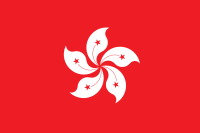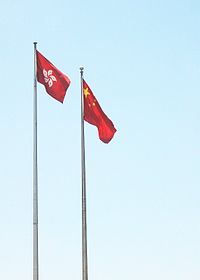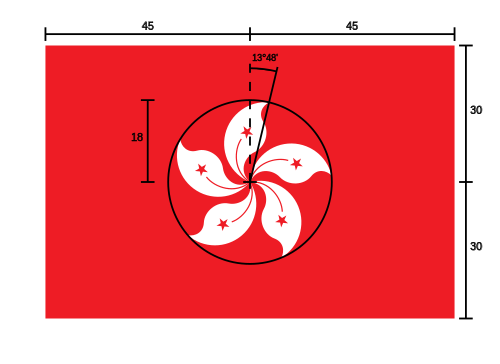Flag of Hong Kong
 | |
| Use | Civil and state flag, civil and state ensign normal |
|---|---|
| Proportion | 2:3 |
| Adopted | Approved on 4 April 1990, used since 1 July 1997 |
| Design | A stylised, white, five-petal Bauhinia blakeana flower in the centre of a red field |
| Designed by | Tao Ho |
Template:Contains Chinese text The Flag of Hong Kong — or Regional Flag of the Hong Kong Special Administrative Region of the People's Republic of China (simplified Chinese: 中华人民共和国香港特别行政区区旗; traditional Chinese: 中華人民共和國香港特別行政區區旗) — features a white, stylised, five-petal Hong Kong orchid tree (Bauhinia blakeana) flower in the centre of a red field. Its design was adopted on 4 April 1990 at the Third Session of the Seventh National People's Congress.[1] The precise use of the flag is regulated by laws passed by the 58th executive meeting of the State Council held in Beijing.[2] The design of the flag is enshrined in Hong Kong's Basic Law, the city's constitutional document,[3] and regulations regarding the use, prohibition of use, desecration, and manufacture of the flag are stated in the Regional Flag and Regional Emblem Ordinance.[4] The flag of Hong Kong was first officially hoisted on 1 July 1997, in the handover ceremony marking the transfer of sovereignty.[5]
Design
Symbolism

The design of the flag carries cultural, political, and regional meanings. The colour itself is significant; red is a festive colour for the Chinese people, used to convey a sense of celebration and nationalism.[6] Moreover, the red colour is identical to that used in the national PRC flag,[7] chosen to signify the link re-established between post-colonial Hong Kong and China. The position of red and white on the flag symbolizes the "one country two systems" political principle applied to the region. The stylized rendering of the Bauhinia blakeana flower, a flower discovered in Hong Kong, is meant to serve as a harmonizing symbol for this dichotomy.[6]
Before the adoption of the flag, the Chairman of the Drafting Committee of the Basic Law explained the significance of the flag's design to the National People's Congress:
The regional flag carries a design of five bauhinia petals, each with a star in the middle, on a red background. The red flag represents the motherland and the bauhinia represents Hong Kong. The design implies that Hong Kong is an inalienable part of China and prospers in the embrace of the motherland. The five stars on the flower symbolize the fact that all Hong Kong compatriots love their motherland, while the red and white colours embody the principle of "one country, two systems".[8]
Construction
The Hong Kong government has specified sizes, colours, and manufacturing parameters in which the flag is to be made. The background of the rectangular flag is red, the same shade of red as that used for the national PRC flag. The ratio of its length to breadth is 1.5. In its centre is a five-petal stylised rendering of a white Bauhinia blakeana flower. If a circle circumscribes the flower, it should have a diameter 0.6 times the entire height of the flag. The petals are uniformly spread around the centre point of the flag, radiating outward and pointing in a clockwise direction. Each of the flower's petals bears a five-pointed red star, a communist and socialist symbolism, with a red trace, suggestive of a flower stamen. The red trace makes each petal look as if it is being divided in half. The heading that is used to allow a flag to be slid or raised onto a pole is white.[7]

Size specifications
This table lists all the official sizes for the flag. Sizes deviating from this list are considered non-standard. If a flag is not of official size, it must be a scaled down or scaled up version of one of the official sizes.[7]
| Size | Length and width in centimetres |
|---|---|
| 1 | 288 × 192 |
| 2 | 240 × 160 |
| 3 | 192 × 128 |
| 4 | 144 × 96 |
| 5 | 96 × 64 |
| Car flag | 30 × 20 |
| Flag for signing ceremonies | 21 × 14 |
| Desktop flag | 15 × 10 |
Colour specifications
The following are the approximate colours of the Hong Kong flag in different colour models. It is listed by web colours in hexadecimal notation, CMYK equivalents*, dye colours, HSL equivalents, and Pantone equivalents.
| Colour | Sample | HTML | CMYK | Textile colour | HSL | Pantone |
|---|---|---|---|---|---|---|
| Red | #FF0000 | 0-100-90-0 | Chinese red | 0°,100%,50% | 186 | |
| White | #FFFFFF | 0-0-0-0 | White | 0°,100%,100% |
*CMYK equivalents based on official downloadable files from Hong Kong's Protocol website (See 2nd external link).
Manufacture regulated
The Regional Flag and Regional Emblem Ordinance stipulates that the Hong Kong flag must be manufactured according to specifications laid out in the ordinance. If flags are not produced in design according to the ordinance, the Secretary for Justice may petition the District Court for an injunction to prohibit the person or company from manufacturing the flags. If the District Court agrees that the flags are not in compliance, it may issue an injunction and order that the flags and the materials that were used to make the flags to be seized by the government.[9]
History
Current design
Before Hong Kong's transfer of sovereignty, a contest was held amongst Hong Kong residents to help choose a flag for post-colonial Hong Kong, with more than 7,000 design submissions. Architect Tao Ho was chosen as one of the panel judges to pick Hong Kong's new flag. He recalled that some of the designs had been rather funny and with political twists: "One had a hammer and sickle on one side and a dollar sign on the other."[10] Six designs were chosen as finalists by the judges, but were all later rejected by the PRC. Ho and two others were then asked by the PRC to submit new proposals.[6]
Looking for inspiration, Ho wandered into a garden and picked up a Bauhinia blakeana flower. He observed the symmetry of the five petals, and how their winding pattern conveyed to him a dynamic feeling. This led him to incorporate the flower into the flag to represent Hong Kong.[6] The design was adopted on 4 April 1990 at the Third Session of the Seventh National People's Congress,[1] and the flag was first officially hoisted seconds after midnight on 1 July 1997 in the handover ceremony marking the transfer of sovereignty. It was hoisted together with the national PRC flag, while the Chinese national anthem, "March of the Volunteers" was played. The Union Jack and the colonial Hong Kong flag were lowered prior to midnight at 11 p.m.[5]
Proper flag protocol

The Hong Kong flag is flown daily from the Chief Executive's official residence, the Government House, the Hong Kong International Airport, and at all border crossings and points of entry into Hong Kong.[11] At major government offices and buildings, such as the Office of the Chief Executive, the Executive Council, the Court of Final Appeal, the High Court, the Legislative Council, and the Hong Kong Economic and Trade Offices overseas, the flag is displayed during days when these offices are working. Other government offices and buildings, such as hospitals, schools, departmental headquarters, sports grounds, and cultural venues should fly the flag on occasions such as the National Day of the PRC (1 October), the Hong Kong Special Administrative Region Establishment Day (1 July), and New Year's Day.[11] The flag should be raised at 8:00 a.m. and lowered at 6:00 p.m. The raising and lowering of the flag should be done slowly; it must reach the peak of the flag staff when it is raised, and it may not touch the ground when it is lowered. The flag may not be raised in severe weather conditions.[12] A Hong Kong flag that is either damaged, defaced, faded or substandard must not be displayed or used.[13]
Displayed together with the national flag

Whenever the PRC national flag is flown together with the regional Hong Kong flag, the national flag must be flown at the centre, above the regional flag, or otherwise in a more prominent position than that of the regional flag. The regional flag must be smaller in size than the national flag, and it must be displayed to the left of the national flag. When the flags are displayed inside a building, the left and right sides of a person looking at the flags, and with his or her back toward the wall, are used as reference points for the left and right sides of a flag. When the flags are displayed outside a building, the left and right sides of a person standing in front of the building and looking towards the front entrance are used as reference points for the left and right sides of a flag. The national flag should be raised before the regional flag is raised, and it should be lowered after the regional flag is lowered.[12]
Half-staff


The Hong Kong flag must be lowered to half-staff as a token of mourning when any of the following people die:[13]
- President of the People's Republic of China
- Chairman of the Standing Committee of the National People's Congress
- Premier of the State Council
- Chairman of the Central Military Commission
- Chairman of the National Committee of the Chinese People's Political Consultative Conference
- Persons who have made outstanding contributions to the People's Republic of China as the Central People's Government advises the Chief Executive.
- Persons who have made outstanding contributions to world peace or the cause of human progress as the Central People's Government advises the Chief Executive.
- Persons whom the Chief Executive considers have made outstanding contributions to the Hong Kong Special Administrative Region or for whom he considers it appropriate to do so.
The flag may also be flown at half-staff when the Central People's Government advises the Chief Executive to do so, or when the Chief Executive considers it appropriate to do so, on occurrences of unfortunate events causing especially serious casualties, or when serious natural calamities have caused heavy casualties.[13] When raising a flag to be flown at half-staff, it should be first raised to the peak of the staff and then lowered to a point where the distance between the top of the flag and the peak of the staff is one third of the length of the staff. When lowering the flag from half-staff, it should be first raised to the peak of the staff before it is lowered.[12]
Prohibition of use and desecration
The Regional Flag and Regional Emblem Ordinance states what manner of use of the Hong Kong flag is prohibited and that desecration of the flag is prohibited; it also states that it is a punishable offence for a person to use the flag in a prohibited manner or desecrate the flag. According to the ordinance, a flag may not be used in advertisements or trademarks,[14] and that "publicly and wilfully burning, mutilating, scrawling on, defiling or trampling" the flag is considered flag desecration.[15] Similarly, the National Flag and National Emblem Ordinance extends the same prohibition toward the national PRC flag.[16][17] The ordinances also allow for the Chief Executive to make stipulations regarding the use of the flag. In stipulations made in 1997, the Chief Executive further specified that the use of the flag in "any trade, calling or profession, or the logo, seal or badge of any non-governmental organisation" is also prohibited unless prior permission was obtained.[11]
The first conviction of flag desecration occurred in 1999. Protesters Ng Kung Siu and Lee Kin Yun wrote the word "Shame" on both the national PRC flag and the Hong Kong flag, and were convicted of violating the National Flag and National Emblem Ordinance and the Regional Flag and Regional Emblem Ordinance. The Court of Appeal overturned the verdict, ruling that the ordinances were unnecessary restrictions on the freedom of expression and in violation of both the Basic Law and the International Covenant on Civil and Political Rights. Upon further appeal, however, the Court of Final Appeal maintained the original guilty verdict, holding that this restriction on the freedom of expression was justifiable in that the protection of the flags played a role in national unity and territorial integrity and constituted a restriction on the mode of expressing one's message but did not interfere with one's freedom to express the same message in other ways.[18]
Leung Kwok-hung, a member of the Legislative Council and a political activist in Hong Kong, was penalised in February 2001, before he became a member of the Legislative Council, for defiling the flag. He was convicted of three counts of desecrating the flag—for two incidents on 1 July 2000 during the third anniversary of Hong Kong's handover to China and for one incident on 9 July of the same year during a protest against elections to choose the Election Committee, the electoral college which chooses the Chief Executive of Hong Kong. Leung was placed on a good-behaviour bond for 12 months in the sum of HK$3,000.[19]
See also
References
- ^ a b "Decision of the National People's Congress on the Basic Law of the Hong Kong Special Administration Region of the People's Republic of China". Government of Hong Kong. 1990-04-04. Retrieved 2009-11-01.
- ^ Laws and Regulations of the People's Republic of China. China Legal Publishing House. 2001. p. iv. ISBN 7-80083-759-9.
- ^ "Basic Law Full Text". Hong Kong Special Administrative Region. Retrieved 2009-03-20.
- ^ "Regional Flag and Regional Emblem Ordinance" (PDF). Bilingual Laws Information System. 1997-07-01. Retrieved 2009-07-25.
- ^ a b Jeffrey Aaronson. "Schedule of Events". TIME. Retrieved 2009-11-01.
- ^ a b c d "忆香港区旗区徽的诞生(上) (Reflecting on the Creation of the Hong Kong SAR Flag and Emblem – Part 1)" (in Simplified Chinese). Wenhui-xinmin United Press Group. 2007-05-24. Retrieved 2009-03-20. and "忆香港区旗区徽的诞生(下) (Reflecting on the Creation of the Hong Kong SAR Flag and Emblem – Part 2)" (in Simplified Chinese). Wenhui-xinmin United Press Group. 2007-05-25. Retrieved 2009-03-20.
- ^ a b c (Schedule 1 of the Regional Flag and Regional Emblem Ordinance) "Regional Flag and Regional Emblem Ordinance" (PDF). Bilingual Laws Information System. 1997-07-01. Retrieved 2009-07-25.
- ^ International Law Reports. Vol. 122. Cambridge University Press. 2002. p. 582. ISBN 978-0-521-80775-3. Retrieved 2009-11-01.
{{cite book}}: Unknown parameter|authors=ignored (help) - ^ (Schedule 5 of the Regional Flag and Regional Emblem Ordinance) "Regional Flag and Regional Emblem Ordinance" (PDF). Bilingual Laws Information System. 1997-07-01. Retrieved 2009-07-25.
- ^ Andrea Hamilton. "Bringing You The Handover: Meet some of the most important men and women working behind the scenes". Asiaweek. Archived from the original on 2007-11-07. Retrieved 2009-03-20.
- ^ a b c "Stipulations For The Display and Use of The National Flag and National Emblem and The Regional Flag and Regional Emblem" (PDF). Protocol Division Government Secretariat of the Hong Kong SAR. Retrieved 2009-11-01.
- ^ a b c "Display of the Flags and Emblems". Protocol Division Government Secretariat of the Hong Kong SAR. 2005-09-06. Retrieved 2009-03-21.
- ^ a b c (Schedule 4 of the Regional Flag and Regional Emblem Ordinance) "Regional Flag and Regional Emblem Ordinance" (PDF). Bilingual Laws Information System. 1997-07-01. Retrieved 2009-07-25.
- ^ (Section 6 of the Regional Flag and Regional Emblem Ordinance) "Regional Flag and Regional Emblem Ordinance" (PDF). Bilingual Laws Information System. 1997-07-01. Retrieved 2009-07-25.
- ^ (Section 7 of the Regional Flag and Regional Emblem Ordinance) "Regional Flag and Regional Emblem Ordinance" (PDF). Bilingual Laws Information System. 1997-07-01. Retrieved 2009-07-25.
- ^ "CAP 2401, Section 6 – Prohibition on certain uses of national flag and national emblem". Bilingual Laws Information System. 1997-07-01. Retrieved 2009-07-25.
- ^ "CAP 2401, Section 7 – Protection of the national flag and national emblem". Bilingual Laws Information System. 1997-07-01. Retrieved 2009-07-25.
- ^ "FINAL APPEAL NO. 4 OF 1999 (CRIMINAL)". Court of Final Appeal. 1999-12-15. Retrieved 2009-07-25.
- ^ "Annual Report 2001". Hong Kong Journalists Association. 2001-08-09. Retrieved 2009-07-25.
External links
- Hong Kong at Flags of the World
- Flags and Emblems of Hong Kong
- CAP 2602 Regional Flag and Regional Emblem Ordinance
- Video, with English captions, from the Hong Kong SAR Information Services Department
